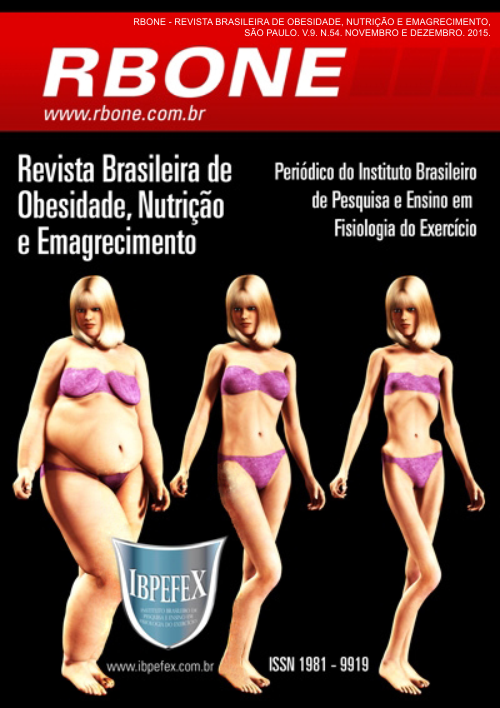Changes in habits: an analysis of body composition and nutrition in college
Abstract
Obesity in adolescence is predictive of adult obesity. Thus, we assessed the factors associated with obesity. This study aimed to identify the change in body composition between college students from 20. Were used as classification, body mass index, waist / hip ratio and fat percentage. Among the entire sample of students, 100% were active. Prevalence of overweight and normal BMI classification were 65% and 15% respectively in the evaluation, unlike the result of the revaluation, which was 35% of individuals classified as overweight. All men (07) are desirable compared to the percentage of fat.
References
-Amato, M.C.M.; Amato, S.J.T.A. Mudança de hábito. São Paulo. Faculdade Ibero-americana. 1997.
-Barra, M.G.B.; Biesek, S.; Fernandes, A.T.P.; Araújo, C.G.S. Comparação do padrão de atividade física e peso corporal total pregressos e atuais entre graduandos e mestre em Educação Física. Revista Brasileira em Ciência do Esporte. Vol. 21. Núm. 2/3. p. 30-35. 2000.
-Carvalho, C. M. R. G.; No, A. M. T.; Teles, J. B. M.; Paz, S. M. R.; Sousa, R. M. L. Consumo alimentar de adolescentes matriculados em um colégio particular de Teresina, Piauí, Brasil. Revista de Nutrição. Vol. 14. Núm. 2. p. 85-93. 2001.
-Fisberg, M. Obesidade na infância e adolescência. São Paulo. Fundo Editorial BYK. p. 9-13. 1995.
-Guedes, D.P.; Guedes, J.E.R.P. Crescimento, composição corporal e desempenho motor de crianças e adolescentes. São Paulo. CLR Balieiro. 1997.
-Lea, F. Guidelines for Graded Execise Testing and Exercise Prescriptin. ACSM. 1986.
-Ley, C. J.; e colaboradores. Sex and menopause associated changes in body fat distribution. Am. J. Clin. Nutr. Vol. 55. p. 950. 1992.
-Madureira, S. A.; Corseuil, H. X.; Pelegrini, A.; Petroski, E. L. Associação entre estágios de mudança de comportamento relacionados à atividade física e estado nutricional em universitários. Rio de Janeiro. 2009.
-Mcardle, W, D; Katch, F, I; Katch, V, L. Fisiologia do Exercício: Energia, Nutrição e Desempenho Humano. 5ªedição. Rio de Janeiro. Guanabara Koogan. 2003.
-Megido, J. L. T.; Xavier, C. Marketing & Agribusiness. 3ª edição. São Paulo. Atlas. 1998.
-Nahás, M.V. Obesidade, controle de peso e atividade física. Londrina. Midiograf. p. 427-433. 1992.
-Pizzinatto, V. T. Obesidade infantil: processo psicossomáticos evolutivo. São Paulo. 1992.
-Repetto, G. Histórico da obesidade. In: Halpen, A.; Godoy, A.F.; Suplicy, H.L.; Ruiz, A. T.; Ruiz, J.V.T. Aspectes pràctics del tractament de I’obesitst infantil. Apunts. Vol. 30. p. 17-34. 1998.
-Rodrigues, E.S.R.; Cheik, N.C.; Mayer, A.F. Nível de atividade física e tabagismo em universitários. Rev Saúde Pública. Vol. 42. p. 672. 2008.
-Rosenbaum, M.; Leibel, R.L. The physiology of body weight regulation:relevance to the etiology of obesity in children. Pediatrics. Vol. 101. Núm. 3. p. 525-39. 1998.
-Rocha, P. E. C. P. Medidas e Avaliação em Ciências do Esporte. Sprint.1995.
-Sztainer, D. N.; e colaboradores. Correlates of Fruit and Vegetable Intake among Adolescents Finding from Project EAT. Preventive Medicine. p. 1-11. 2003.
-World Health Organization. Report of a WHO Consultation on Obesity. Preventing and managing the global epidemic. WHO. Geneve. 1998.
Authors who publish in this journal agree to the following terms:
- Authors retain the copyright and grant the journal the right of first publication, with work simultaneously licensed under the Creative Commons Attribution License BY-NC which allows the sharing of the work with acknowledgment of the authorship of the work and initial publication in this journal.
- Authors are authorized to enter into additional contracts separately for non-exclusive distribution of the version of the work published in this journal (eg, publishing in institutional repository or book chapter), with acknowledgment of authorship and initial publication in this journal.
- Authors are allowed and encouraged to post and distribute their work online (eg, in institutional repositories or on their personal page) at any point before or during the editorial process, as this can bring about productive change as well as increase impact and impact. citation of published work (See The Effect of Free Access).






